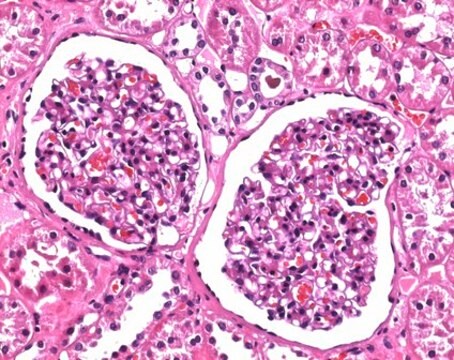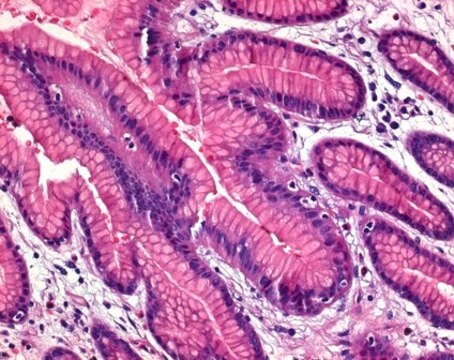47608
Formaldeide
for molecular biology, BioReagent, ≥36.0% in H2O (T)
Sinonimo/i:
Formalina
About This Item
Prodotti consigliati
Grado
for molecular biology
Livello qualitativo
Densità del vapore
1.03 (vs air)
Tensione di vapore
52 mmHg ( 37 °C)
Nome Commerciale
BioReagent
Stato
liquid
Temp. autoaccensione
572 °F
contiene
~10% methanol as stabilizer
Concentrazione
≥36.0% in H2O (T)
36.0-38.0% (aldehyde method)
tecniche
electrophoresis: suitable
Impurezze
≤0.03% free acid (as HCOOH)
Residuo alla calcinazione
≤0.05% (as SO4)
pH
2.8-4.0
Densità
1.09 g/mL at 20 °C
1.09 g/mL at 25 °C (lit.)
Anioni in tracce
chloride (Cl-): ≤10 mg/kg
sulfate (SO42-): ≤20 mg/kg
Cationi in tracce
Ca: ≤5 mg/kg
Cd: ≤1 mg/kg
Co: ≤1 mg/kg
Cr: ≤1 mg/kg
Cu: ≤1 mg/kg
Fe: ≤1 mg/kg
K: ≤20 mg/kg
Mg: ≤1 mg/kg
Mn: ≤1 mg/kg
Na: ≤100 mg/kg
Ni: ≤1 mg/kg
Pb: ≤1 mg/kg
Zn: ≤1 mg/mL
λ
2 M in H2O
Assorbanza UV
λ: 260 nm Amax: 0.01
λ: 280 nm Amax: 0.01
Compatibilità
in accordance for electrophoresis of RNA in agarose gels
Temperatura di conservazione
room temp
Stringa SMILE
[H]C([H])=O
InChI
1S/CH2O/c1-2/h1H2
WSFSSNUMVMOOMR-UHFFFAOYSA-N
Cerchi prodotti simili? Visita Guida al confronto tra prodotti
Descrizione generale
It is an aliphatic aldehyde that is widely used in industrial applications for the synthesis of several chemicals such as melamine formaldehyde, urea-formaldehyde, phenol formaldehyde and industrial resins, paraformaldehyde, polyols, chelating agents, slow release fertilizers, 1,4-butanediol and hexamethylenetetramine.
Applicazioni
- denaturation and separation of RNA molecules
- anti-bacterial treatment
- fixation of cells
- in the fixation of human spermatogonial stem cell transplantation (SSCT).
- to crosslink T- cell acute lymphoblastic leukemia protein/DNA complex during chromatin immunoprecipitation.
- in fixing zebra fish larvae for neutrophil staining.
Avvertenza
Principio
Non trovi il prodotto giusto?
Prova il nostro Motore di ricerca dei prodotti.
Prodotti correlati
Avvertenze
Danger
Indicazioni di pericolo
Classi di pericolo
Acute Tox. 2 Inhalation - Acute Tox. 3 Dermal - Acute Tox. 3 Oral - Carc. 1B - Eye Dam. 1 - Flam. Liq. 3 - Muta. 2 - Skin Corr. 1B - Skin Sens. 1 - STOT SE 1 - STOT SE 3
Organi bersaglio
Eyes,Central nervous system, Respiratory system
Codice della classe di stoccaggio
3 - Flammable liquids
Classe di pericolosità dell'acqua (WGK)
WGK 3
Punto d’infiammabilità (°F)
133.0 °F - closed cup
Punto d’infiammabilità (°C)
56.11 °C - closed cup
Dispositivi di protezione individuale
Faceshields, Gloves, Goggles, type ABEK (EN14387) respirator filter
Scegli una delle versioni più recenti:
Possiedi già questo prodotto?
I documenti relativi ai prodotti acquistati recentemente sono disponibili nell’Archivio dei documenti.
I clienti hanno visto anche
Articoli
rganoid culture products to generate tissue and stem cell derived 3D brain, intestinal, gut, lung and cancer tumor organoid models.
Il team dei nostri ricercatori vanta grande esperienza in tutte le aree della ricerca quali Life Science, scienza dei materiali, sintesi chimica, cromatografia, discipline analitiche, ecc..
Contatta l'Assistenza Tecnica.










